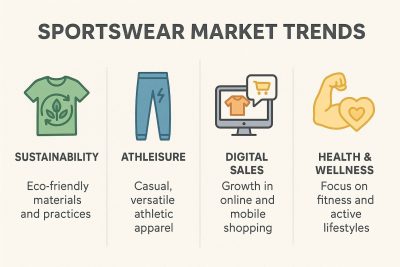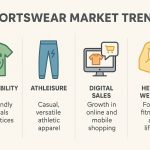 The global sportswear market is experiencing significant evolution in 2025, driven by shifting consumer preferences, technological advancements, and an increased focus on sustainability. Valued at over $400 billion, the industry is no longer limited to performance apparel but is expanding into lifestyle, wellness, and fashion domains. As consumers demand more versatile, comfortable, and eco-friendly options, brands are adapting to remain competitive.
The global sportswear market is experiencing significant evolution in 2025, driven by shifting consumer preferences, technological advancements, and an increased focus on sustainability. Valued at over $400 billion, the industry is no longer limited to performance apparel but is expanding into lifestyle, wellness, and fashion domains. As consumers demand more versatile, comfortable, and eco-friendly options, brands are adapting to remain competitive.
1. Athleisure Continues to Dominate
Athleisure—apparel that blends athletic functionality with casual style—remains a dominant trend. Consumers increasingly seek clothing that offers both performance and aesthetic appeal, allowing them to seamlessly transition from the gym to daily life. This trend has blurred the lines between sportswear and streetwear, with brands like Nike, Adidas, Lululemon, and newcomers like Vuori capitalizing on this convergence. The COVID-19 pandemic accelerated this shift, and even in a post-pandemic world, the comfort and utility of athleisure continue to drive demand.
2. Sustainability is No Longer Optional
Sustainability has transitioned from a trend to a necessity. Consumers, particularly Millennials and Gen Z, are holding brands accountable for their environmental impact. This has led to a surge in the use of recycled materials, eco-friendly dyes, and circular production models. Brands such as Patagonia, Allbirds, and Adidas are leading the way with transparent supply chains and product lines made from ocean plastic, organic cotton, and bio-based fibers. Regulatory pressure and ESG (Environmental, Social, and Governance) investment criteria are further encouraging sustainable innovation across the industry.
3. Technological Integration and Smart Apparel
Smart textiles and wearable technology are becoming integral to sportswear. From moisture-wicking and temperature-regulating fabrics to garments embedded with sensors for real-time biometric tracking, consumers are gravitating toward clothing that enhances performance and monitors health. Companies like Under Armour and Hexoskin are pioneering smart sportswear, catering to both professional athletes and fitness enthusiasts looking to optimize their routines.
4. Personalization and Direct-to-Consumer Growth
As digital commerce grows, brands are investing in personalization and direct-to-consumer (DTC) strategies. AI-driven platforms are enabling customized product recommendations, virtual try-ons, and bespoke apparel, improving customer engagement and loyalty. DTC models not only offer better margins for brands but also provide deeper insights into customer behavior, aiding in product development and targeted marketing.
5. Gender-Inclusive and Adaptive Sportswear
Inclusivity in sportswear is expanding, with brands designing products that cater to all genders, body types, and physical abilities. Adaptive apparel—designed for people with disabilities—is also gaining traction, reflecting a broader commitment to accessibility and representation in the industry. Major players like Nike and Tommy Hilfiger are investing in these areas, reinforcing the importance of diversity in sportswear design and marketing.
Conclusion
The sportswear market in 2025 is defined by innovation, sustainability, and inclusivity. As consumer expectations evolve, brands that embrace these trends while staying true to performance and style will continue to thrive. The intersection of fashion, technology, and social responsibility is not only reshaping the industry but also setting the stage for a more responsive and resilient future.






